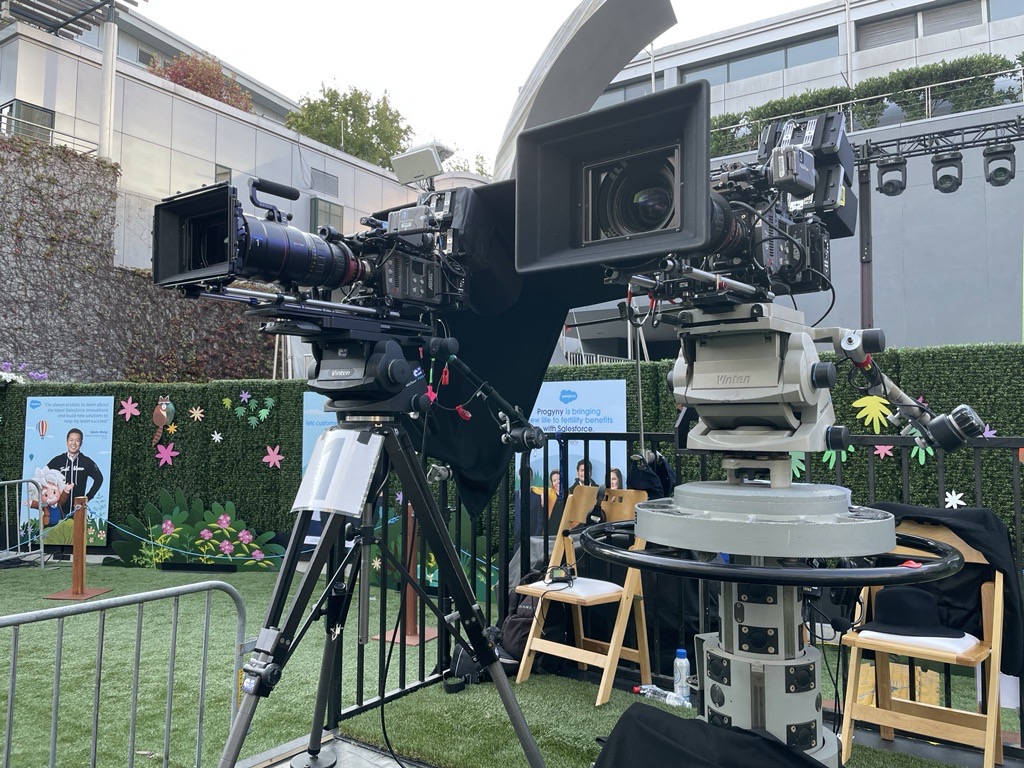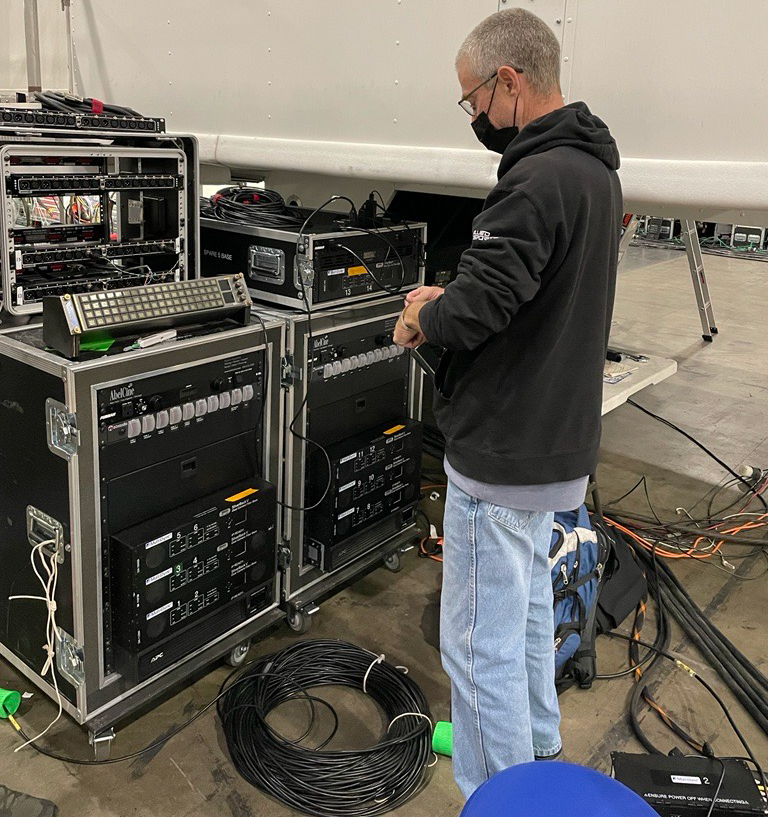To deliver an engaging experience for both sets of viewers during the event, Salesforce requested a more cinematic look than most online events’ traditional deep focus/live broadcast style. AbelCine responded to the challenge by outfitting the production with an extensive supply of cameras, optics, and support gear. In addition to rental packages, AbelCine provided production and technical support for the event.
Ian McCausland, Camera Technology Specialist at AbelCine, handled outfitting the cameras and overseeing operations. Digital Camera Technician Neil Staff concentrated on the base station setup and overall signal flow. Director of Technology Matt Giblin also supported the effort. Several broadcast production trucks and over 35 miles of fiber optic cabling connected to the cameras were strategically placed around the venue at the Moscone Convention Center in downtown San Francisco. In total, 1,200 crew members supported six event venues with multi-cam coverage. AbelCine’s team also worked directly with several partners, including ARRI and NEP.

Creating A Cinematic Look
To deliver the cinematic aesthetic desired by the event organizers, AbelCine’s team needed to adapt Super 35mm sensor cinema cameras and PL-mount optics to function in a live broadcast environment. The solution included nearly two dozen ARRI Amira and ALEXA Mini cameras. Optics comprised Angenieux 19.5-94mm, 28-76mm, 45-120mm, and 24-290mm Optimo zooms, as well as a Canon 17-120mm zoom lens. A sizable complement of ARRI, Canon, and Preston follow focus kits, SmallHD monitors, and MultiDyne SMPTE fiber optic transmitter adaptors rounded out the primary package for Dreamforce.
One of the key challenges to delivering cinematic shallow depth-of-field is maintaining proper focus throughout a take. In cinema production, a focus error can be rectified by redoing the shot for another take. But in a live production, like Dreamforce, the focus must be constantly perfect. To facilitate this with the camera operators, Ian McCausland developed a FIZ (focus, iris, zoom) solution specifically tailored to live operation.
“We set up the FIZ with the iris control from the trucks from their remote control panels,” says Ian. “Each operator had zoom and focus controls going through cmotion camin units, [which route iris control from the truck back to the corresponding motor on the lens and control zoom and focus demand for the operators.] The tricky part is that ARRI has one protocol and Sony has another, so we used Sony CNA-1 camera control network adaptors to translate between the two control types.”

Making the Connections
Connecting the many different cameras, FIZ, tally, audio/video, and other signals to the trucks was another major challenge for the project. “We used the MultiDyne fiber optic conversion system to connect everything,” says Neil Staff. “Each camera had an operator with one DIT and a laptop seeing all the different feeds mirrored back to the truck. The original signal was recorded to AJA Ki Pros on the trucks. Finally, a LUT was generated in the truck, and applied to each individual camera image.”
“The venue was San Francisco city streets, which they shut down and dressed up like a movie set,” explains Matt Giblin. “There was a little forest camp with an amphitheater and a stage. The trucks were parked about half a mile from the stages. This was a pretty state-of-the-art venue, so many fiber runs were already part of the infrastructure. Each camera could see a program feed and send and receive the camera controls, signal, etc.”
The highly sophisticated trucks capturing, switching, and broadcasting the event had to synchronize with the camera crews perfectly. “Just imagine, these 50-feet long trucks are typically broadcasting Monday night football,” observes Ian. “They’re super high-end and prepared to just roll into a stadium, pop out their expansion wings, and go. Everything inside the truck is hundreds of millions of dollars of Grass Valley switchers and the like. They had several 56’ Cat diesel generator trailers just to power everything.”
Operator Challenges
Compounding the project’s complexity was the need to maintain a consistent operator style across many different camera units. “It was a hybrid approach, with multiple cameras up on pedestals with 17-inch teleprompters,” says Ian. “You combine that with an Optimo 24-290mm and an Amira, and you’ve got a formidable package to run on. But to the operators’ credit, they all jumped in enthusiastically, and we got it done.”
One of the highlights of the three-day event was a live concert performance from the band Foo Fighters. As with the many other live sessions, the team captured the concert with a multi-cam cinematic aesthetic. “It was interesting that a set designed for a corporate conference was also used for a more traditional rock show,” notes Matt. “We constantly shifted around the coverage between different venues, but the concert was the event we covered with the most cameras.”
Completing the Event
Taking stock of the show’s ultimate success and its achievement of cinematic multi-camera for live streaming, the AbelCine team learned a lot. “This was one of the largest scale projects we’d done to date, with over 115 cases of gear,” recalls Ian. “I’ve been using ARRI cameras for thirty years and have tremendous respect for them, but this was an intense field test for the Amiras. The night we had 16 cameras going through a rainstorm was the night they really proved themselves. We also proved we can create and deliver a cinematic live show because we came away with something that looks beautiful.”
Matt agrees, noting the critical compromise in live cinematic work is the degree of aesthetics vs. practicality. “It comes down to how forgivable the live setup is, like, in a rock show, you can occasionally get away with a shot going out of focus, but maybe a comedy show needs to be locked in focus constantly,” says Matt. “It’s also having a reasonable f-stop to work from. That’s a conversation between the director and the DP, ‘we want this to look good, but we also want it to be in focus.’ Another big part of it is experience.”
Asked if he thinks cinematic-style event cinematography is here to stay, Ian answers in the affirmative. “Steve Jobs opened this door with streaming product launches because he gave you something new and exciting to look at,” he says. “Tech companies realize they have a global audience, and not everyone can make it to the in-person sessions. So, they need to reproduce not only the excitement of the live experience but also deliver a very polished presentation. That’s the impression they give people about their brand and culture.”
















AbelCine encourages comments on our blog posts, as long as they are relevant and respectful in tone. To further professional dialog, we strongly encourage the use of real names. We reserve the right to remove any comments that violate our comment policy.
AbelCine publishes this blog as a free educational resource, and anyone may read the discussions posted here. However, if you want to join the conversation, please log in or register on our site.
We use Disqus to manage comments on this blog. If you already have a Disqus account registered under the same email as your AbelCine account, you will automatically be logged in when you sign in to our site. If not, please create a free account with Disqus using the same email as your AbelCine account.